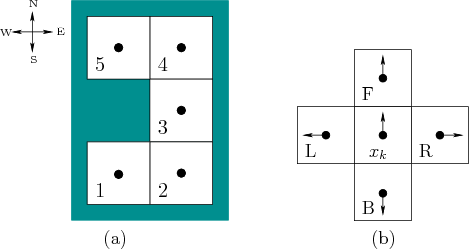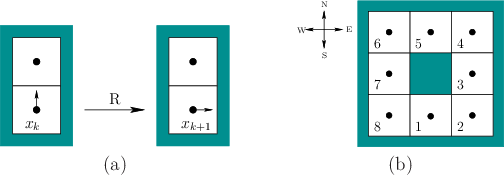
Next: Solving the passive localization Up: 12.2 Localization Previous: 12.2 Localization
Many interesting lessons about realistic localization problems can be
learned by first studying a discrete version of localization.
Problems that may or may not be solvable can be embedded in more
complicated problems, which may even involve continuous state spaces.
The discrete case is often easier to understand, which motivates its
presentation here. To simplify the presentation, only the
nondeterministic I-space
![]() will be considered; see Section
12.2.3 for the probabilistic case.
will be considered; see Section
12.2.3 for the probabilistic case.
Suppose that a robot moves on a 2D grid, which was introduced in Example 2.1. It has a map of the grid but does not know its initial location or orientation within the grid. An example is shown in Figure 12.2a.
 |
To formulate the problem, it is helpful to include in the state both the position of the robot and its orientation. Suppose that the robot may be oriented in one of four directions, which are labeled N, E, W, and S, for ``north,'' ``east,'' ``west,'' and ``south,'' respectively. Although the robot is treated as a point, its orientation is important because it does not have a compass. If it chooses to move in a particular direction, such as straight ahead, it does not necessarily know which direction it will be heading with respect to the four directions.
Thus, a state, ![]() , is written as
, is written as ![]() , in which
, in which ![]() is a
position and
is a
position and ![]() is one of the four directions. A set of states at
the same position will be denoted with special superscripts that point
in the possible directions. For example,
is one of the four directions. A set of states at
the same position will be denoted with special superscripts that point
in the possible directions. For example,
![]() indicates the
set of states for which
indicates the
set of states for which ![]() and the direction may be north
(N) or east (E), because the superscript points in the north
and east directions.
and the direction may be north
(N) or east (E), because the superscript points in the north
and east directions.
 |
The robot is given four actions,
| (12.11) |
The robot has one simple sensor that can only detect whether it was
able to move in the direction that was attempted. The sensor space is
![]() , and the sensor mapping is
, and the sensor mapping is
![]() . This yields
. This yields
![]() if
if ![]() and
and
![]() place the robot at different positions, and
place the robot at different positions, and
![]() otherwise. Thus, the sensor indicates whether the robot has moved
after the application of an action.
otherwise. Thus, the sensor indicates whether the robot has moved
after the application of an action.
Nondeterministic uncertainty will be used, and the initial I-state
![]() is always assumed to be
is always assumed to be ![]() (this can easily be extended to
allow starting with any nonempty subset of
(this can easily be extended to
allow starting with any nonempty subset of ![]() ). A history I-state at
stake
). A history I-state at
stake ![]() in its general form appears as
in its general form appears as
| (12.13) |
The passive localization problem
starts with a given map, such as the one shown in Figure
12.2a, and a history I-state, ![]() , and computes the
nondeterministic I-state
, and computes the
nondeterministic I-state
![]() . The active
localization problem is to compute some
. The active
localization problem is to compute some ![]() and sequence of actions,
and sequence of actions,
![]() , such that the nondeterministic I-state is as
small as possible. In the best case,
, such that the nondeterministic I-state is as
small as possible. In the best case,
![]() might become a
singleton set, which means that the robot knows its position and
orientation on the map. However, due to symmetries, which will
be presented shortly in an example, it might not be possible.
might become a
singleton set, which means that the robot knows its position and
orientation on the map. However, due to symmetries, which will
be presented shortly in an example, it might not be possible.